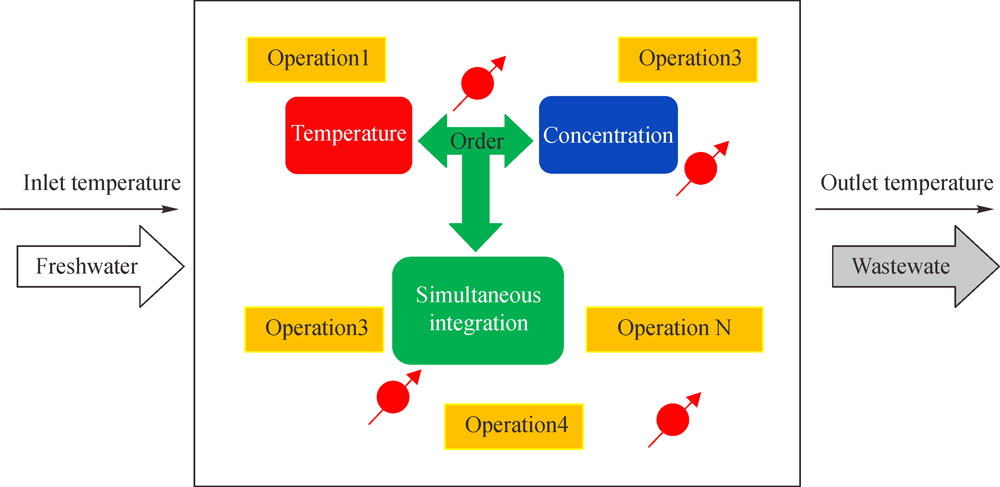

Frontiers of Chemical Science and Engineering >
A conceptual methodology for simultaneous optimization of water and heat with non-isothermal mixing
Received date: 14 May 2016
Accepted date: 16 Jul 2016
Published date: 12 May 2017
Copyright
A new conceptual methodology is proposed to simultaneously integrate water allocation and energy networks with non-isothermal mixing. This method employs a simultaneous model and includes two design steps. In the first step, the water allocation network (WAN), which could achieve the targets of saving water and energy, is obtained by taking account the temperature factor into the design procedure. The optimized targets of both freshwater and energy are reached at this step which ensures this approach is a simultaneous one. In the second step, based on the obtained WAN, the whole water allocation and heat exchange network (WAHEN) is combined with the non-isothermal mixing to reduce the number of heat exchangers. The thus obtained WAHEN can achieve three optimization targets (minimization of water, energy and the number of heat exchangers). Furthermore, the effectivity of our method has been demonstrated by solving two literature examples.

Yanlong Hou , Wanni Xie , Zhenya Duan , Jingtao Wang . A conceptual methodology for simultaneous optimization of water and heat with non-isothermal mixing[J]. Frontiers of Chemical Science and Engineering, 2017 , 11(2) : 154 -165 . DOI: 10.1007/s11705-016-1593-z
| 1 |
Chen Z Y, Wang J T. Heat, mass, and work exchange networks. Frontiers of Chemical Science Engineering, 2012, 6(4): 484–502
|
| 2 |
Savelski M J, Bagejewicz M J. Design and retrofit of water utilization systems in refineries and process plants. AIChE Annual Meeting, Los Angeles, 1997
|
| 3 |
Ahmetović E, Ibrić N, Kravanja Z, Grossmann I E. Water and energy integration: A comprehensive literature review of non-isothermal water network synthesis. Computers & Chemical Engineering, 2015, 82: 144–171
|
| 4 |
Bagajewicz M J, Pham R, Manousiouthakis V. On the state space approach to mass/heat exchanger network design. Chemical Engineering Science, 1998, 53(14): 2595–2621
|
| 5 |
Bagajewicz M J, Rodera H, Savelski M. Energy efficient water utilization systems in process plants. Computers & Chemical Engineering, 2002, 26(1): 59–79
|
| 6 |
Dong H G, Lin C Y, Chang C T. Simultaneous optimization approach for integrated water-allocation and heat-exchange networks. Chemical Engineering Science, 2008, 63(14): 3664–3678
|
| 7 |
Liao Z W, Rong G, Wang J D, Yang Y R. Systematic optimization of heat-integrated water allocation networks. Industrial & Engineering Chemistry Research, 2011, 50(11): 6713–6727
|
| 8 |
Chen Z Y, Hou Y L, Li X D, Wang J T. Simultaneous optimization of water and heat exchange networks. Korean Journal of Chemical Engineering, 2014, 31(4): 558–567
|
| 9 |
Bogataj M, Bagajewicz M J. Design of non-isothermal process water networks. 17th European Symposium on Computer Aided Process Engineering. Computer Aided Chemical Engineering, 2007, 24: 377–382
|
| 10 |
Bogataj M, Bagajewicz M J. Synthesis of non-isothermal heat integrated water networks in chemical processes. Computers & Chemical Engineering, 2008, 32(12): 3130–3142
|
| 11 |
Boix M, Pibouleau L, Montastruc L, Azzaro-Pantel C, Domenech S. Minimizing water and energy consumptions in water and heat exchange networks. Applied Thermal Engineering, 2012, 36: 442–455
|
| 12 |
Manan Z A, Tea S Y, Wan S R. A new technique for simultaneous water and energy minimization in process plant. Chemical Engineering Research & Design, 2009, 87(11): 1509–1519
|
| 13 |
George J, Sahu G C, Bandyopadhyay S. Heat integration in process water networks. Industrial & Engineering Chemistry Research, 2011, 50(7): 3695–3704
|
| 14 |
Thongpreecha S, Siemanond K. Water and heat exchanger network design for fixed-flowrate system. Chemical Engineering Transactions, 2014, 39: 193–198
|
| 15 |
Huang Y L, Edgar T F. Knowledge based design approach for the simultaneous minimization of waste generation and energy consumption in a petroleum refinery. In: Rossiter A P, ed. Waste Minimization Through Process Design. New York: McGraw-Hill Companies, 1995, 181–196
|
| 16 |
Savulescu L, Smith R. Simultaneous energy and water minimisation. AIChE Annual Meeting, Miami Beach, Florida, 1998
|
| 17 |
Savulescu L E, Kim J, Smith R. Studies on simultaneous energy and water minimisation – Part I: Systems with no water re-use. Chemical Engineering Science, 2005, 60(12): 3279–3290
|
| 18 |
Savulescu L E, Kim J K, Smith R. Studies on simultaneous energy and water minimization – Part II: Systems with maximum re-use of water. Chemical Engineering Science, 2005, 60(12): 3291–3308
|
| 19 |
Wan Alwi S R, Ismail A, Manan Z A, Handani Z B. A new graphical approach for simultaneous mass and energy minimization. Applied Thermal Engineering, 2011, 31(6-7): 1021–1030
|
| 20 |
Leewongtanawit B, Kim J K. Improving energy recovery for water minimisation. Energy, 2009, 34(7): 880–893
|
| 21 |
Martínez-Patiño J, Picón-Núñez M, Serra L M, VerdaV.Systematic approach for the synthesis of water and energy networks. Applied Thermal Engineering, 2012, 48: 458–464
|
| 22 |
Hou Y L, Wang J T, Chen Z Y, Li X D, Zhang J L. Simultaneous integration of water and energy on conceptual methodology for both single- and multi-contaminant problems. Chemical Engineering Science, 2014, 117: 436–444
|
| 23 |
Liu Z Y, Yang Y, Wan L Z, Wang X, Hou K H. A heuristic design procedure for water-using networks with multiple contaminants. AIChE Journal. American Institute of Chemical Engineers, 2009, 55(2): 374–382
|
| 24 |
Zheng X S, Feng X, Cao D L. Design water allocation network with minimum freshwater and energy consumption. Process System Engineering, 2003, 388–393
|
| 25 |
Feng X, Li Y C, Shen R J. A new approach to design energy efficient water allocation networks. Applied Thermal Engineering, 2009, 29(11-12): 2302–2307
|
| 26 |
Wang Y P, Smith R. Waste-water minimisation. Chemical Engineering Science, 1994, 49(7): 981–1006
|
/
| 〈 |
|
〉 |